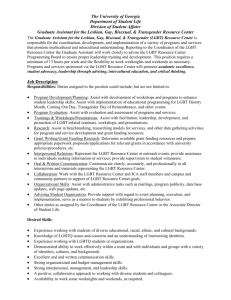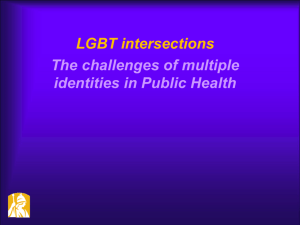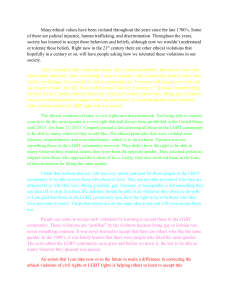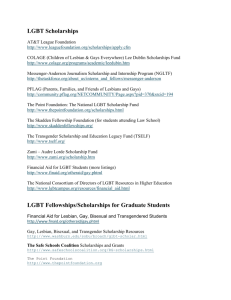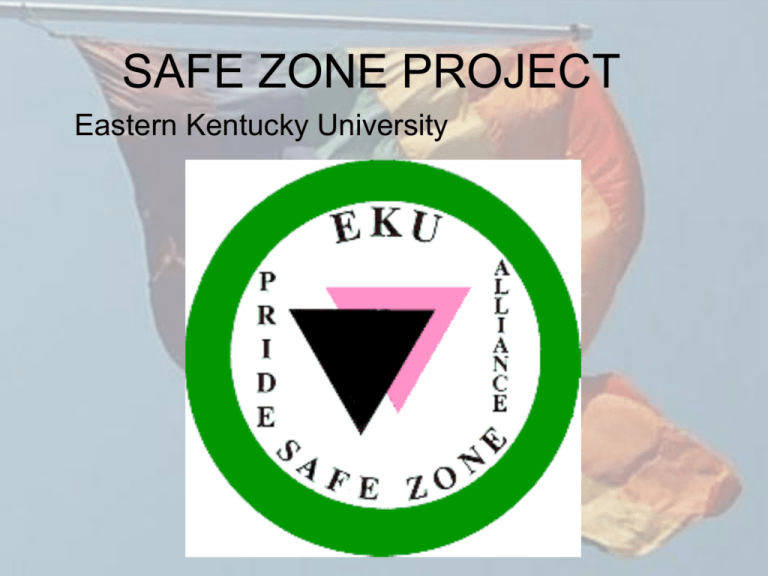
SAFE ZONE PROJECT
Eastern Kentucky University
COMMON
LANGUAGE
COMMON LANGUAGE
• LGBT
– Lesbian Gay Bisexual Transgender
– Not a phonetic acronym
– Traditionally placed with the “G” before
“L”
– Feminist movement switched placement
– GLBT or LGBT ok
COMMON LANGUAGE
• Queer
– Was used to demean and outcast
homosexuals and perceived homosexuals
– Adopted in 80s by homosexuals as an
attempt to nullify slander and lay claim to
identity
– Political correctness of this term still up for
debate
COMMON LANGUAGE
• Homosexual
– Emotionally, physically, and/or sexually
attracted and/or committed to members of the
Same Sex
– Not an act or behavior but a state of being
COMMON LANGUAGE
• Sexual Orientation
– The state of being homosexual, heterosexual,
bisexual
• Gender Identity
– How an individual sees their own gender,
masculine, feminine, or some combination
along the continuum
COMMON LANGUAGE
• Lesbian
– Used to refer to female homosexuals only
COMMON LANGUAGE
• Gay
– Can be used to refer to both male and female
homosexuals
– More commonly used when refer to males only
• Use to say “Gentleman” when referring to a group of
people, now say “Ladies and Gentleman”
• Use to say “Gay” when referring to group of
homosexuals, now say “Lesbian and Gay”
COMMON LANGUAGE
• Bisexual
– Emotionally, physically, and/or sexually
attracted and/or committed to members of the
either sex
– Attraction to both sexes may not be equal
– Degree of attraction may very over time
– Not an act or behavior but a state of being
COMMON LANGUAGE
• Transgender
– Hardest for most people to understand
• Lack of understanding between sex and gender
• People tend to think in either/or with regard to sex
and gender
COMMON LANGUAGE
• Transgender
– Sex and gender
• Sex is polarity of anatomy
• Gender is polarity of appearance and behavior
COMMON LANGUAGE
• Transgender
– Either/or physical
• Physical sex characteristics and chromosomal
patterns fall along a spectrum
– Size, shape, morphology, number, and combination of
sex organs can vary,
– Mosaic genetics – XX and XY patterns in same person,
also can have extra chromosomes
• Society makes distinction between male and
female to make communication and understanding
easier
COMMON LANGUAGE
• Transgender
– Either/or gender
• Society interprets gender cues and then assigns a
masculine or feminine gender
– Dress, hair style, tone or inflection of voice, hold of body
• Assumption, men = masculine, women = feminine
COMMON LANGUAGE
• Transgender
– Either/or gender
• Some historical fluidity of strict gender roles
– Women can show traditional masculine traits in the form
of dress, hair style, occupation
– Men arguable can show some traditional traits in the form
of hair style and occupation but not in areas such as
dress or body manner
COMMON LANGUAGE
• Transgender
– Either/or gender
• Gender norms are not symmetrical
• Women have gained a wider range of expression
• Men have not so much
COMMON LANGUAGE
• Transgender
– Societies non-acceptance of free expression
along gender range and adherence to strict
either/or sex classification creates the
definition for transgender
• Someone who’s sex classification or gender
expression does not fit societal norms
COMMON LANGUAGE
• Transgender
– Label of transgender is a personal label
• Individuals accept or reject the label on a personal
level
– Transgenderism can take many forms and
does not necessarily regard physical sex and
perceived gender variations for each
individual
COMMON LANGUAGE
• Transgender
– Some forms
• Transsexual – internal sense of being male or
female differs from physical sex
– Male-to-female (MTF)
– Female-to-male (FTM)
– Most do not surgically modify their bodies
- cost, lack of medical coverage, pain, dissatisfaction
with results and methods
– Refer to these individual as the sex they identify as or
use the pronoun “ze” in place of he or she
– Most are not homosexual
COMMON LANGUAGE
• Transgender
– Some forms
• Androgynist– person appearing and identifying as
neither man nor woman, male nor female
– presenting a gender either mixed or neutral
– Do not use pronouns he or she when referring to these
individuals use “ze” or use no pronoun.
COMMON LANGUAGE
• Transgender
– Some forms
• Crossdresser / Transvestite – person who enjoys
wearing clothes identified with the gender opposite
of their physical sex and identified gender
– Refer to selves as male or female according to physical
sex
– Rarely are they homosexual
• Does not include Drag Queens or Drag Kings
– Performance artists who bend gender norms for money
– Most are homosexual
COMMON LANGUAGE
• Ally
– “a person who is a member of the dominant or
majority group who works to end oppression
in his or her personal and professional life
through support of, and as an advocate with
and for, the oppressed population"
(Washington and Evans 1991)
COMMON LANGUAGE
• Homophobia
– Irrational fear of homosexuals/ homosexuality,
or any behavior, belief, or attitude that doesn’t
conform to sex-role stereotypes
– Homophobia is not strictly a heterosexual problem
• Heterosexism
– Assumption that everyone is heterosexual or
should be
COMMON LANGUAGE
• Internalized Oppression
– Process by which a member of an oppressed
group comes to accept and live out the
inaccurate myths/ stereotypes applied to the
oppressed group
COMMON LANGUAGE
• In the Closet
– To hide one’s sexual orientation or
gender identity
– To keep a job, housing, friends, etc., to survive in a
homophobic situation
– Many LGBT individuals are “Out” in some
situations and “Closeted” in others
COMMON LANGUAGE
• Coming Out
– To publicly declare one’s sexual
orientation or gender identity
– Can be spoken or a physical act
– Is not a single event but a life-long process
– Each new situation means deciding whether to
coming out again or not
What is Safe Zone
What is Safe Zone
• A way to identify LGBT allies within a
campus community and provide those
allies, and the people who seek them out,
with support and information
– No one universal Safe Zone program
• Each institution creates their own program and
tailors it to their specific needs, experience,
expertise, and resources
• Goes by many names, Safe Space, Safe Harbor,
Safe on Campus, Ally Support
What is Safe Zone
• Allies who chose to participate in the
program identify themselves through the
use of a sticker or placard
– LGBT individual who need help seek out
these markers
– Can feel safe to communicate with the person
displaying it about LGBT issues personal or
otherwise.
PURPOSE
PURPOSE
• To easily identify LGBT allies in the
campus community
– LGBT individuals are not easily identifiable
– LGBT supporters are not easily identifiable
PURPOSE
• Placing a Safe Zone sticker
– Sends a message of a strong personal
commitment to the purpose of, and individuals
involved in, the Safe Zone program in a
prominent, non-verbal way
– Sends a message of willingness to provide
help, advice, support, understanding, and
trust, in a non-judgmental environment
PURPOSE
• There is a plethora of misinformation
about LGBT individuals
• There is hostility toward LGBT individuals
– The Safe Zone program makes it possible for
individuals seeking help or advice to find it
without having to
•
•
•
•
Fear for their emotional well being
Fear for their physical well being
Need to explain themselves
Need to educate or re-educate instead of receiving
services
PURPOSE
• To provide support and information to
allies who can then provide support and
information to the LGBT individual
– No one is expected to, nor is it possible for
anyone to know everything
– Safe Zone provides an educational and
support network
PURPOSE
• EVERYONE has a right to their own
opinion
– Safe Zone is NOT meant to change people or
their beliefs
• This means not trying to change people who
disagree with homosexuality as well as not trying
to change homosexuals themselves
• It does not mean ignoring misinformation, myths,
or stereotypes
PURPOSE
• Voluntary
– Safe Zone is completely voluntary
– Members are going beyond EKU’s minimum
requirements of nondiscrimination
– It needs to be voluntary to protect all participates
involved and to ensure the true purpose of the
program is fulfilled
• NO NEGATIVE connotation or feedback is
permitted for those who choose not to participate
WHY SAFE
ZONE
WHY SAFE ZONE
• 2001 The National Gay and Lesbian Task
Force conducted a nation wide study of
faculty, staff, students, administrators at
US universities
• Those universities who agreed to
participate were some of the nations most
gay friendly
WHY SAFE ZONE
– 19% feared for safety because of
Sexual Orientation or Gender Identity
– 29% had their ability to work or learn
interfered with because of SO or GI
– 51% felt need to conceal SO or GI
–60% of those were students
– 79% of those who carried out the
harassment were students
WHY SAFE ZONE
• Forms of harassment
– 89% derogatory remarks
– 48% verbal threats
– 39% anti-LGBT graffiti
– 38% pressure to remain silent about SO or GI
– 33% written harassment
– 11% threats of physical violence
– 10% threats of exposure of SO or GI
– 10% actual physical assault
WHY SAFE ZONE
• Where harassment occurred
• Of Faculty, Staff,
Administrators
– 57% public campus
settings
– 46% walking on campus
– 29% campus workplace
– 29% residence halls
– 23% classrooms
• Of Students
– 63% public campus
settings
– 40% residence halls
– 30% class rooms
MORE THAN
TOLERANCE
MORE THAN TOLERANCE
• There are 8 basic stages in dealing
with homosexuality
– They are individual place holdings not steps
up or down a ladder but they do build on each
other
– No one is confined to one spot
– What a person identifies within these stages
is not a statement of maturity/development
rather a statement of beliefs
MORE THAN TOLERANCE
However,
• If an individual can not currently identify
with stage 4-8 they may find it difficult to
be a Safe Zone identified ally
– People will seek advice and guidance,
– Safe Zone allies must be comfortable with
themselves and the issues in order to help
MORE THAN TOLERANCE
1. Active Participation
– Directly supporting LGBT oppression
– Laughing at or telling jokes that put down LGBT
people or people who don’t fit traditional male/female
stereotypes
– Avoiding/encouraging others to avoid behavior that is
not sex-stereotyped
– Verbal/physical harassment of LGBT people or
heterosexuals who do not conform to sex-stereotypes
– Working for anti-gay legislation
MORE THAN TOLERANCE
2. Denying/ Ignoring
-
Inaction that supports LGBT oppression
Unwillingness/inability to understand the
effects of homophobic/heterosexist actions
passively accept LGBT oppression
“Business as Usual” attitude
MORE THAN TOLERANCE
3. Recognizing, but No Action
–Recognition of homophobic/ heterosexist
actions and their harmful effects
–But no action to interrupt the situation
– Example: hearing a friend tell a “Queer Joke,”
recognizing it as homophobic, not laughing,
also not saying anything to friend
MORE THAN TOLERANCE
4. Recognizing and Interrupting
–Recognizing homophobic/heterosexist
actions
–Taking action to stop them
–Telling the friend, jokes making fun of
gays/lesbians aren’t funny
–Realizing been avoiding an activity
because it might appear gay, deciding to
participate
MORE THAN TOLERANCE
5. Educating Self
–Take actions to learn about LGBT people,
heterosexism/homophobia
–Can include
– Reading books or LGBT publications, attending
workshops, talking to others, joining
organizations
MORE THAN TOLERANCE
6. Questioning and Dialoguing
–Attempt to begin to educate others about
homophobia/heterosexism
–Go beyond recognizing homophobic/
heterosexist actions to engaging individuals
in a dialogue about the actions
–Attempt to help others increase their
awareness/knowledge of homophobia/
heterosexism
MORE THAN TOLERANCE
7. Supporting and Encouraging
–Support and encourage the antihomophobic/ anti-heterosexist actions of
others
–Helping others interrupt oppression even if
they are offended
MORE THAN TOLERANCE
8. Initiating and Preventing
–Anticipating/ identifying homophobic
institutional practices or individual actions
then working to change them
– Example: teacher changing a heterosexist
“Family Life” lesson
GUIDELINES
FOR MEMBERS
GUIDELINES FOR MEMBERS
YOU ARE NOT ALONE
Safe Zone allies are here to support each
other as well as the individuals who come
to them for help
GUIDELINES FOR MEMBERS
• Respect privacy/ confidentiality
– Except in cases of physical assault or hate crimes
– Follow EKU’s written policy
GUIDELINES FOR MEMBERS
• Refer individuals to counseling when
necessary
– Having trouble coping, functioning, concentrating
– Overly distressed, severe lack of sleep, severe weight
changes, loss of interest in previously enjoyable
activities
– Express thoughts of suicide
– You feel overwhelmed or worried
– Use your best judgment
GUIDELINES FOR MEMBERS
• Remember there are levels to sexual
identity development
– Example: not identifying one self as gay or lesbian but
engaging in same sex relationships
• Stages of sexual identity development can be found in the
Safe Zone manual
– Don’t assume, use appropriate language
• If You Need Help Ask
– Dr. Sue Strong: 2-3515
– Each other
GUIDELINES FOR MEMBERS
• Be an advocate, advisor, teacher, mentor
• Do lunch, have coffee
• Help find other social supports for the
individual to engage in
GUIDELINES FOR MEMBERS
• Have clear, professional yet friendly
boundaries
– No romantic or sexual relationships with those
who seek you out through the Safe Zone
program
GUIDELINES FOR MEMBERS
• Tape the Safe Zone sticker to your door or
in a visible place in your workstation
– If someone tears it down or defaces it, we will
replace it.
– If you leave EKU, change offices, want to
withdraw from the program please remove
your sticker and let us know
GUIDELINES FOR MEMBERS
• Use your resources wisely
– The Safe Zone Manual
– A resource for all Safe Zone members
– Read it, familiarize yourself with its contents
– It can help you understand and help others
– Copy sections for those who come to you
– It does not represent all the info you will need
–www.education.eku.edu/faculty_staff/strong/safezone.htm
GUIDELINES FOR MEMBERS
• Places to find additional information
– Human Rights Campaign
– Kentucky Fairness Alliance
– PFlag – Parents Family and Friends of Lesbians and
Gays
– GLAAD – Gays and Lesbians Alliance Against
Defamation
– GLSEN – Gay Lesbian Straight Education Network
– National Gay and Lesbian Task Force
– The National Consortium of Directors of LGBT
Resources in Higher Education
– Any of the references for this presentation
GUIDELINES FOR MEMBERS
• Websites for other Safe Zone programs
– Western Michigan University
• http://www.salp.wmich.edu/lbg/GLB/default.html
– Texas A&M
• http://allies.tamu.edu
– Iowa State University
• (http://www.public.iastate.edu/~lgbtss/safezones/)
– Virginia Commonwealth University
• http://www.students.vcu.edu/counsel/safezone/
– University of Wyoming
• http://uwacadweb.uwyo.edu/SAFEZONE/
– For a complete list of Colleges and Universities that offer Safe
Zone type programs go to The National Consortium of Directors
of LGBT Resources in Higher Education website
GUIDELINES FOR MEMBERS
• Safe Zone is a living program
– Help it breathe and grow
– E-mail info you find and think should be added to
the manual to sue.strong@eku.edu
– Share information you find with other members
GUIDELINES FOR MEMBERS
• Be aware of the issues facing LGBT
individuals
• Educate yourself and others
• Be ready to stand up and help when
needed
Take pride in your self
identification as a
LGBT ally and in your
role as a Safe Zone
Member
REFRENCE
• Blackless, Melanie, Anthony Charuvastra, Amanda Derryck, Anne
Fausto-Sterling, Karl Lauzanne, and Ellen Lee. 2000. “How sexually
dimorphic are we?” American Journal of Human Biology 12:151166.
• Intersex Society of North America. 2005. “What is Intersex.” Intersex
Society of North America.
<http://www.isna.org/faq/what_is_intersex> (November 2005)
• Kingston, Matthew J. 1999. “Safe Zone.” Indian University.
<http://www.indiana.edu/~out/safezone/index.shtml> (November
2005)
• Nangeroni, Nancy. 2004. “Transgressing Gender Norms.” Gender
Talk. <http://www.gendertalk.com/tgism/tgism.shtml> (November
2005)
• Poynter, Kerry. 2005. “Frequently Asked Questions.” National
Consortium of Directors of LGBT Resources in Higher Education.
<http://www.lgbtcampus.org/faq/safe_zone.html> (November 2005)
REFRENCE
•
•
•
•
•
•
Rankin, Susan R. 2003. “Campus Climate for Gay, Lesbian, Bisexual, and
Transgender People: A National Perspective.” New York: The National Gay
and Lesbian Task Force Policy Institute. p. 24-33.
Spruill, Martha Ann. 2000. “Safe Zone Statement of Purpose.” Virginia
Commonwealth University Safe Zone.
<http://www.students.vcu.edu/counsel/safezone/purpose.html> (November
2005)
Texas A&M University, Allies Committee. 2005. “Bisexuality Basics” Aggie
Ally <http://allies.tamu.edu/resources/bibasics.htm> (November 2005)
Tubbs, Nancy Jean. 2004. “Safe Zone/Allies Programs.” National
Consortium of Directors of LGBT Resources in Higher Education.
<http://www.lgbtcampus.org/faq/safe_zone_roster.html> (November 2005)
University of Wyoming. 2004. “What is Safe Zone.” University of Wyoming.
<http://uwacadweb.uwyo.edu/SAFEZONE/describesz.asp> (November
2005
Washington, J., Evans, N. J. 1991. “Becoming an Ally.” Beyond tolerance:
Gays, lesbians and bisexuals on campus. Alexandria, VA: American College
Personnel Association. p.195.



